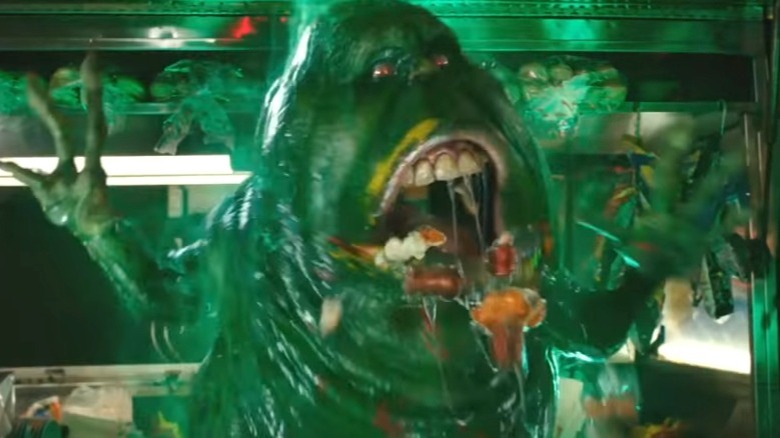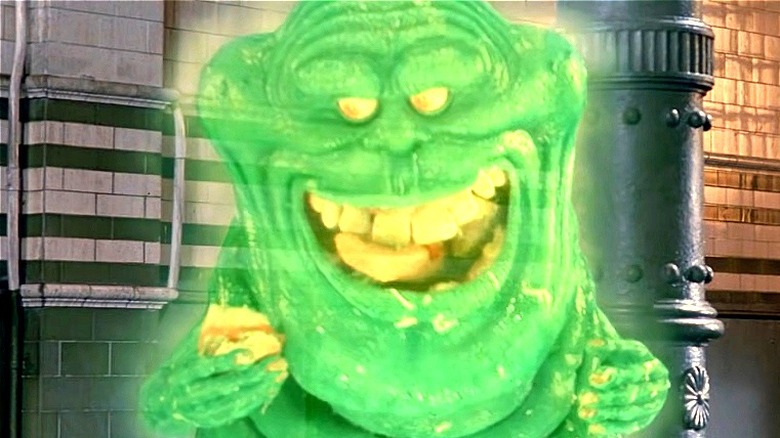Ghostbusters' Paul Feig And Katie Dippold Originally Wrote Slimer As The Ghost Of A Gangster
Few '80s classics have the cultural impact of "Ghostbusters." The film remains one of the most beloved comedies of the decade, with the stories surrounding its creation just as intriguing as their ghost-chasing adventures. Even those who have never seen "Ghostbusters" probably can name at least one aspect of the well-liked franchise. The ubiquitous logo alone proves its staying power. The logo, which features a ghost barred by a circle with a line through it appears on just about everything, from socks to specialty foods.
The original "Ghostbusters" and its sequel featured a host of notable characters, extending to the otherworldly creations that inhabit both. Slimer is arguably the best-known of the franchise's supernatural characters. This green-globbed figure with a big mouth and an even bigger appetite found popularity after the first film. His memorable — albeit short — moments in the Sedgewick Hotel see him confront Peter Venkman (Bill Murray) to hilarious effect. Featuring as part of the subsequent cartoon series only increased Slimer's appeal to viewers of all ages.
MovieWeb's Ray Clough encapsulated its popularity in a ghostly ranking. "When you consider that this creature has the highest escape rate of any ghost captured by the Ghostbusters, only stays at the finest hotels, and even works a side hustle as a bus driver, you've got to admit that he seems to have it all figured out," he wrote. While audiences might have embraced the quirky character with a mischievous nature, they often overlooked one element; a remake over 30 years later looked like it was about to change all that. Paul Feig, who directed the 2016 version of "Ghostbusters," gave viewers a few answers about a pivotal mystery surrounding Slimer's origin story.
Paul Feig crafted an interesting origin story
The push to revive "Ghostbusters" came decades after it became an '80s box office sensation. Director Paul Feig took on the project after years in development; pairing with screenwriter Katie Dippold, the filmmaker behind "Bridesmaids" sought something that would go beyond the original incarnation. Of course, he knew there had to be an homage to the original material while offering a new perspective.
For the pair, it was essential to delve deeper into the elements which made the original film work. One of the biggest points came from the science behind the ghosts themselves. "Unlike Katie, who believes in ghosts, I'm a skeptic. If I am going to do something like this, it has to make sense science wise," Feig said in 2016 (via the Tracking Board). That method of approaching the popular characters extended to Slimer. The ghost would finally get a chance to have an origin story — something missing in the 1984 film.
Feig talked to Wired about what could have been regarding Slimer's origin story. It all stems from ghosts' former lives as humans. Feig and Dippold wanted a backstory that would be a fun reveal as to who Slimer was before venturing into the afterlife (via YouTube). For the green ghostly star, his proposed backstory revealed him to be a gangster who had a less-than-peaceful death. The Ghostbusters would venture into a restaurant where the gangster had previously murdered a waiter after a botched order, eventually getting executed for the crime. Finding him in the restaurant's kitchen would prove to be a different meeting spot for the team, with a hotel put to use in the '84 version.
Slimer was originally set as an homage
In another change to "Ghostbusters," the physical aspects of Slimer would also come into play. Feig looked at using the potential instability of the team's new tech to change the character into a look that viewers would recognize. An unstable setting on the proton packs provided the catalyst in Feig and Dippold's vision. "...it blows his legs off and then it turns him green and then he starts to distort and so he becomes Slimer," the director told Wired. This means viewers would have seen Slimer in human — albeit ghostly — form before the transformation. The human form may have looked like someone very familiar to comedy fans if Feig had held true to the original version.
Slimer's initial character origins may not have been so clear. Nevertheless, the story behind its use in the 1984 version of "Ghostbusters" adds to the mystique that Feig and Dippold were hoping to grow with their remake. Steve Johnson, who helped create monsters for iconic horror and sci-fi got the call to make Slimer. The special effects master found out the character would itself be an homage. In his book, "Rubberhead Volume II: Sex, Drugs and Special FX," Johnson wrote about the legendary comedian who became the basis for Slimer's design. "So I pulled out a stack of headshots of John Belushi, poured a gram of cocaine on it and started chopping lines up," Johnson noted (via The Wrap).
Belushi was originally set to star in the original film alongside "Saturday Night Live" co-star Dan Aykroyd; unfortunately, it proved to be only a dream as Belushi died in 1982 due to a drug overdose. "The morning that John died I was typing a line out for him," Aykroyd told Extra (via ComicBook). "I got the call that he had gone, so even though he wasn't there anymore I finished the movie."


